|
XWA, Montreal: the Very First Radio Broadcast in Canada:
The Real Story, at Last
© Arthur E. Zimmerman
Pre-amble
For generations, merely turning a knob or punching a button has brought in continuous streams of radio or television broadcasting, and we think it the most natural thing in the world.
That belies the years of grinding labour in theoretical physics and practical engineering work that went into harnessing and refining these electromagnetic-based media products that we take for granted.
The Question of the Very First Radio Broadcast in Canada
The very first voice broadcast in Canada is reputed to have taken place in 1919 by the Marconi Wireless Telegraph Company of Canada, Ltd., (MWTCC) in Montreal, through its licenced station XWA
(later re-licenced as 9AM and then as CFCF). Much has been published about this first wireless telephone (W/Tp) broadcast by this station, but it has all been speculative, with unsupported memories
and lots of false, invented dates, some even trying to push the event back well into the WW I period (1). Even five years after the actual first public experiment, no records or documentation could be
found in the MWTCC archives or in government records (2). The Marconi engineers who did the first experimental W/Tp transmissions did not keep any logs of their work and, until the present research,
the best that we had were diverse recollections of veterans, made years later.
Novel Long-Distance Communication with Electricity: The Pleasure Telephone
Following the technical miracles of distance communication by Morse's telegraph and Bell's telephone, people tried to push these systems into new directions. In fact, the idea of some sort of public
distribution of voice and music started in the late 19th century by companies in Europe and the Americas that sent out news, plays and even live opera performances through their telephone networks (3).
Even in Canada; in 1878, the Bell Telephone Exchange transmitted a Sunday service from Zion Church, Montreal (4), and there is an undated early report of another such transmission in Montreal, c. 1876 (5).
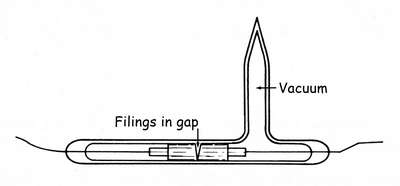
|
Branly coherer (1890)
Physicist Edouard Branly's ingenious little coherer was able to receive incoming electromagnetic signals to complete a
battery circuit to a buzzer, then quickly break that circuit so that the system was again set up to receive and register the next incoming
signal; thus, a series of Morse-like dots and/or dashes.
The coherer was a small, T-shaped evacuated glass tube with tight-fitting nickel rods shoved into the horizontal arms below the T Each of the
pushed-in metal rods was connected to the opposite pole of a battery and the T to an aerial. In a little space left between the metal rods was a
small amount of iron-nickel-silver filings. A burst of electromagnetic radiation received by the aerial, as from a spark, caused the filings
between the rods to adhere into a sort of chain, completing the circuit with the battery and activating an in-line buzzer. Also in the battery
circuit was a wire coil containing a free-sliding magnetic rod. The sudden battery current through the coil would cause the magnet rod to move,
like a little hammer, but with a momentary physical delay, and strike the coherer gently. This jarring would cause the chain of metal filings
between the rods to collapse, to de-cohere, thus breaking the battery circuit and shutting off the buzzer. The system was now ready to react
to a second burst of electromagnetic radiation, making it possible for Marconi to transmit Morse Code.
|
|
|
Guglielmo Marconi's Wireless Telegraph (W/Tg)
Guglielmo (also known as William) Marconi, was born in Bologna, son of a Jameson & Sons Irish whisky heiress and a landed Italian nobleman. The boy was raised on his father's estate, but spoke both
Italian and perfect English. He had only private tutors and was most interested in physics, particularly in Maxwell-Hertzian electromagnetic waves, and especially in different types of aerials for the
reception of those waves. He attended technical college in Livorno, Tuscany, then was permitted to work in Prof. Augusto Righi's lab in Bologna. Righi, Marconi, Sir Oliver Lodge and others were then
experimenting with induction coils to produce spark discharges, rigging up their primitive electromagnetic receptors to ring bells or to open locks. At some point, Righi gave the boy Branly's recently
invented little coherer, a simple, mechanical device which made it possible to receive an incoming electromagnetic wave and then to rapidly re-set the receiving system to quickly detect another incoming wave.
Marconi realized that, with this coherer, it would be possible for operators to detect and distinguish individual Morse dots and dashes, not as line telegraphy but as wireless telegraphy (W/Tg). With improvised
aerials, he was able to receive such wireless messages at a mile and a half distance. Then, through his mother's connections, he went to England to work with Sir William Preece, Chief Engineer of the British
Post Office. Here, his system was improved to the point where Marconi patented his W/Tg work in 1896, although criticized by Lodge as merely a combination of two known technologies. Soon, Marconi was experimenting
with longer and longer distances and then with the exciting idea of wireless communications between ships at sea.
An early success was the W/Tg alarm received from the East Goodwin Lightship after it was rammed by the steamship R.F Matthews (6). Later, Marconi himself reported the International Yacht Races by W/Tg from
the S.S. Ponce off New York City (7). In 1900, he formed the Marconi Wireless Telegraph and Signal Company in England, along with cousin Jameson Davies.
After many short-distance tests of his wireless methodology, Marconi reported, in late 1901, the sensational reception of the code letter "S" (three dots) atop Signal Hill in St. John's, Newfoundland,
transmitted from Poldhu, Cornwall, England (8). Marconi was, however, unable to repeat that cross-ocean experiment for years, raising skepticism that the three dots, or any dots, had actually been received at
St. John's through the electrical storms then raging over the Atlantic (9). Only Marconi and his assistant attested to a successful reception of the three dots, a situation made dubious since Marconi had a great
deal to lose by a failure. In fact, Marconi himself did not have the technical expertise to perfect his system and certainly not to advance toward voice transmission by wireless. After much uncredited developmental
work by Dr. J. Ambrose Fleming (10), and some successful trials, Marconi's trans-Atlantic Wireless Telegraphy Service was finally launched in 1907.
Progress From W/Tg Toward Wireless Telephony (W/Tp) or Radio; Including Canadian Pioneers
Inspired by Marconi's successes, from late in the last decade of the nineteenth century, inventive amateurs were sending and receiving messages by Marconi-type W/Tg, or electromagnetic spark, using home-made spark
coils and primitive detectors, such as galena (lead sulphide), silicon or carborundum crystals with "cats' whiskers" or else with Branly's little coherer. Prof. James L. W. Gill was the first in the Americas to
demonstrate W/Tg on Marconi principles, at a meeting of the McGill Physical Society, McGill University, Montreal, on Nov. 6, 1897. In 1902, he demonstrated W/Tg signals passing through stone walls, during his
Queen's University Convocation lecture (11). Right behind Gill was another Canadian-born pioneer of W/Tg, William Joseph Clarke of Trenton, Ontario, who did his public demonstration in New York City on Nov. 24, 1897 (12).
Meanwhile, seeking methods to enable the transmission of voice by wireless, other inventors tried to adapt the discharges of sparks by ingenious methods. Teenager Francis McCarty demonstrated voice broadcasting by
spark transmission in 1902 and 1905 (13). Lee de Forest, with his Radiophone, successfully transmitted voice from the Eiffel Tower to Marseilles, 550 miles away (14). One of his many publicity stunts, using a
ship-type oscillating spark transmitter, was to broadcast excerpts from the stage of the Metropolitan Opera, New York, on January 13, 1910; likely Emmy Destinn in "Cavalleria Rusticana" and Caruso in "I Pagliacci" (15).
As it turned out, the music was almost inaudible to reporters at de Forest's headquarters, drowned out by interference by the Manhattan Beach Station of the United Wireless Company.
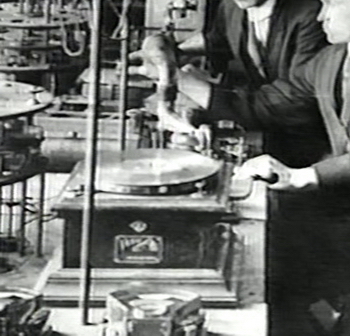
|
|
Charles "Doc" Herrold's modified Victor II gramophone in use in his broadcasting studio, San Jose, California, c. 1915.
|
|

|
|
A recent photograph of a pristine Victor II gramophone,
identical to the one used by Charles "Doc" Herrold in his studio
(courtesy of Domenic DiBernardo)
|
|
|
Charles D. "Doc" Herrold in San Jose, California, broadcast news and music on his multiple modulated, high-frequency direct current spark or arc transmitter, his Art Fone, essentially a mechanical system, from 1912-17.
He assigned himself the call FN in 1912, then SJN and was officially licenced as 6XE in 1916, before WW I put a stop to all non-military wireless activities. Initially, juice for his arc transmitter was obtained by
illegally connecting into the local lines of the Santa Fe Street Railway. Herrold had a scheduled program at 8 p.m. every Wednesday, called "The Little Hams Show", on which he played records on a modified Victor II gramophone,
the big horn replaced by a very small horn which pointed backwards toward his microphone (16). From a simulation, using Herrold's original equipment in an issued video about Herrold (17), the received sound was fairly
clear but underlain by a low buzz.
In Europe, a claim as the first to broadcast voice was by Raymond Braillard and a company of Belgians who had station OTL on the grounds of the Royal Castle at Laeken near Brussels, and aired programs of music every
Saturday at 5 p.m. from March 28, 1914 (18).
Reginald Fessenden's W/Tp Broadcast, Christmas Eve, 1906
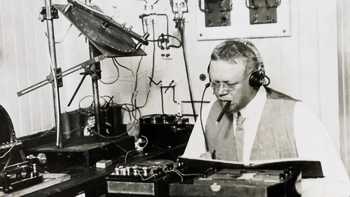
|
|
Reginald Aubrey Fessenden (1866-1932)
|
|
|
Other inventors, after some struggling to transmit voice and music with the unlikely spark technology, began making strides in quite radical directions. Reginald Fessenden, a Canadian engineer working for the U.S.
Weather Bureau on Cobb Island, Virginia, on the remote Atlantic coast, initially using a modulated spark system with over 10,000 discharges/second, broadcast the very first voice message in history, on December 23, 1900.
In a simulation of that first broadcast, the voice was quite dim and there was a good deal of static. Then he figured out a novel technology incorporating an Alexanderson-designed high-frequency alternator, which he
modified to give 75-100 kHz. That apparatus, quite by chance, transmitted his voice from Brant Rock, Massachusetts, to Machrihanish, Scotland, in November, 1906. His was an ingenious heterodyne system in which voice
was superimposed on a high frequency current oscillation produced by a series of compressed-air spark gaps; that is, on a perfect continuous sine-wave carrier or continuous wave (19).
On December 21, 1906, Fessenden demonstrated W/Tp over eleven miles from Brant Rock to his Plymouth station, for a group of invited dignitaries. That broadcast included recordings of talking and music played on his
Edison Triumph, Model B phonograph, all received clearly and distinctly; better than on the line-telephone. At that point, his W/Tp communication could be made satisfactorily between ships ten to fifteen miles apart (20).
That Christmas Eve, Fessenden sent an extended voice and music broadcast from Brant Rock. According to his letter of January 29, 1932, to former associate Samuel M. Kintner, he had advertised three days in advance to
amateurs and ships of the U.S. Navy and the United Fruit Company which had bought his equipment. He had told the operators by W/Tg that he intended broadcasting speech, music and singing on Christmas Eve and again on
New Year's Eve. Fessenden began the December 25 broadcast by signalling "CQ, CQ, CQ" in Morse, for "listen all stations". According to the letter, he opened with a short speech on what he was going to do, then played
Handel's "Largo" on the phonograph, followed by "a violin solo by me, being a composition by Gounod called ‘O, Holy Night', and ending up with the words ‘Adore and be Still', which I sang one verse of, in addition to
playing the violin...". Then he read the text of Luke 2:14, "Glory to God in the highest...." and finally wished listeners a Merry Christmas, reminding them that he would broadcast again on New Year's Eve.

|
|
Reginald Fessenden's laboratory at Brant Rock, Massachusetts, showing his Edison Triumph, Model B on the bench at left, c. 1906-08.
|
|
|
There has been skepticism that Fessenden's Christmas Eve broadcast was actually made. Fessenden did not keep any records of it and no reception reports have ever been found, except for mentioning in his letter that
it was received in Norfolk, Virginia. Other contention, aside from the 26-year lateness of the revelation, is based mainly upon his apparent confusion over the music played. Fessenden was a bit of a musician, playing
the violin and the piano, and he surely knew his Christmas music. Somehow, in the letter, he telescoped Adolph Adam's "O, Holy Night" and Gounod's Christmas Anthem "Abide and be Still". On the positive side, he did
have a phonograph in his laboratory, did broadcast from it according to the article on the December 21 airing (20) and that very machine is illustrated in two of his 1908 papers (21). It was an Edison Triumph
Model B phonograph, vintage 1906. Of figure F in the ATJ article, he said that it "shows a phonograph transmitting music and speech wirelessly". The only other question is the identity of that Handel cylinder.
Reports have circulated that it was sung by a contralto, but there is no documented evidence of that (22), and no contemporary cylinder recording of the "Largo" by a contralto has turned up in any archive or collection.
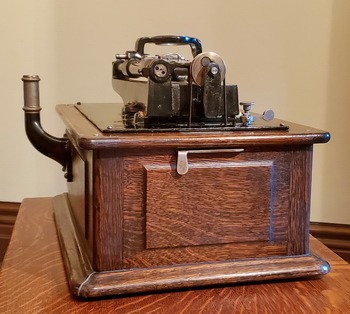
|
|
Reginald Fessenden broadcast cylinder recordings from his Brant Rock radio station in late 1906,
using the recently released Edison Triumph, Model B, identical to the one shown here.
(courtesy of Bill Pratt)
|
|
|
Fessenden repeated his broadcast on New Year's Eve, reporting reception from some places in the West Indies and surely from vessels of the U.S. Navy and of the United Fruit Company (UFC). Again, he did not keep those
messages, but suggested that logs of reception should be with the U.S. Navy and with the UFC. Diligent searching has turned up no such logs.
We do know that Fessenden was a real straight-shooter about his many technical achievements, and it's unlikely that he would have invented a broadcast for the letter to Kintner. It's entirely possible that Fessenden
never thought much of the Christmas broadcast since the aim was point-to-point communication and he still hadn't achieved the hoped-for range. After all, the W/Tp was a commercial venture to him and his National
Electric Signalling Company, all about manufacturing and selling his equipment.
Fessenden's novel carrier-wave system should have been the breakthrough to modern radio technology, but his work was ignored and bypassed, as inventors continued to struggle to adapt spark technology for voice
transmission; that is, Marconi's "whiplash" or "abrupt impulse" method, basically of spark on-and-off. The world would have to endure another decade of that struggle until Lee de Forest placed a grid between the
anode and cathode of Dr. J. Ambrose Fleming's rectifying diode "valve" of 1904, almost accidentally creating a triode or Audion tube (23). Finally, this was a revolutionary little non-mechanical device that could
both generate high-frequency carrier waves and detect and amplify continuous-wave radio signals for audibility. The Audion was the direct road to modern radio.
The New W/Tp by English Marconi
In 1913, Capt. H.J. Round of English Marconi was told of Meissner's work at Telefunken in Berlin, generating continuous waves with a triode oscillator, essentially with an Audion valve. Round adapted the triode into
the Marconi Company's "C" tube for high frequency generation and amplification and the "T" type for transmitting, both then fitted into a small wireless telephony set with a range of 100 miles (24). Marconi engineer
Maj. Charles E. Prince, working with the Royal Flying Corps in 1917, realizing that W/Tp was far more audible in a noisy aeroplane than clickety W/Tg, modified Capt. Round's little transmitter and produced the
Marconi Mark I and then the Mark II W/Tp for 2-way voice communication between aeroplanes and aeroplanes to ground (25). The Marconi Company's work was behind that of the Americans, who were already using W/Tp for
directing pilots for reconnaissance and bombings before the Armistice (26). After secret demonstration to the British Military General Staff, Maj. Prince's W/Tp system was issued to the R.A.F. by November 1918,
right at the end of the war, as the Mark II choke-controlled telephone set (27).

|
|
An early Marconi W/Tp set with an Audion-type valve, devised by Capt. Round, and demonstrated in England in 1914.
|
|
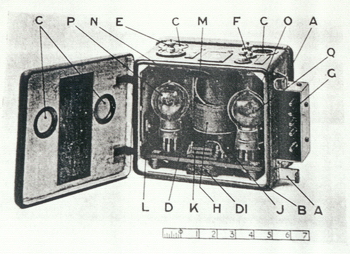
|
|
The little Marconi Telephone Wireless Aircraft Transmitting Set, Mark II, likely similar to the one used in the first Canadian Marconi wireless voice broadcast, March 21, 1919. The transmitter, in a box of canvas-covered thin wood, fitted with wire-gauze windows, weighed 6.25 lb and measured 9.75 x 7.25 x 5.5 inches. The two bulbs were the power oscillator ("C valve), left, and the control valve ("T" valve), right, with the choke and condenser between them The pilot's helmet would have been fitted with high-inductance "headreceivers" (Marconi Signals Experimental Establishment, Pamphlet No. 3, October, 1917; marked "SECRET").
|
|
|
Radio Broadcasting using de Forest-type Vacuum Tubes
In Holland, Hans Idzerda, got the Philips Company to produce its own copies of Audion tubes, the iduret generatorlamp or Dutch IDZ valve. His broadcasting outfit was licenced as station PCGGW and aired its
"Radio Soiree-Musicale" by continuous narrow-band FM at a wavelength of 1070 metres, on Thursday evenings from November 6, 1919 (28).
Frank Conrad in Pittsburgh, an engineer and amateur before the war, obtained the new transmitting tubes from Westinghouse, where he worked, set up a transmitter in his garage in 1919, talking to other "hams",
broadcasting records by request and even live performances. He was granted the amateur call 8XK and scheduled weekly concerts early in 1920. Sales of receivers grew because of Conrad's work, until Westinghouse
persuaded him to build a powerful transmitter in the company plant and to broadcast on a more regular basis. Those broadcasts stimulated even more sales of Westinghouse receivers and the newly licenced station
went on the air as KDKA at 360 metres on November 2, 1920 at 8:00 p.m. (29). KDKA claims that it was the first real radio broadcaster in the Americas; real in the sense that the initial broadcast was pre-announced
in the press, was heard and then reported as being heard. KDKA was actually beaten for the first real broadcast in the Americas by station XWA of the MWTCC in Montreal, on May 20, 1920.
The Early Business of the Marconi Wireless Telegraph Company of Canada (MWTCC)
From the middle of the first decade of the twentieth century, the MWTCC was contracted to build chains of W/Tg stations on Canada's east coast, up the St. Lawrence and along the Great Lakes, and for these
services trained and supplied the operators. These stations were run by the Dominion Government and served as vital communications with commercial and government ships on the coast and in major inland waterways.
The MWTCC factory in Glace Bay, Cape Breton, built and tested the lighter W/Tg equipment (except for the motor generators and switchboards bought from commercial suppliers), until the disastrous fire in August, 1909,
and then re-located to Delorimier Street in Montreal that December. Through the windows of the little Delorimier factory, people at that tramway transfer corner would be startled by the lightning-like flashes from
the heavy synchronous spark-gaps inside and by the crashings of the high-frequency currents being tested (30).
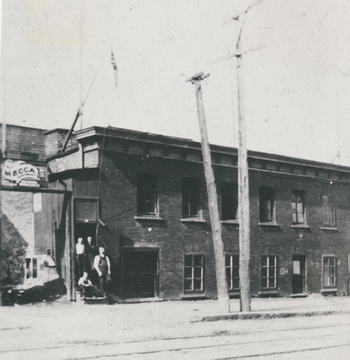
|
|
The first Marconi factory in Montreal, on Delorimier Street,
from 1909.
|
|
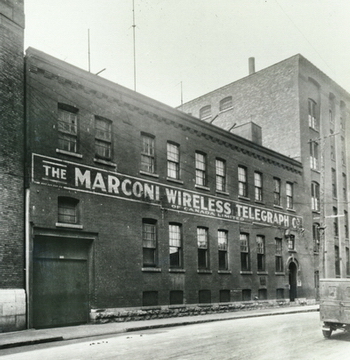
|
|
The third Marconi factory in Montreal, at 173 William Street,
built c. 1917.
|
|
|
The MWTCC Test Room, Montreal, and XWA Licenced for Spark
All amateur wireless experimentation among the Allied countries, including the British Empire, was closed down from early in WW I, though the military continued experimenting with W/Tg and with voice broadcasting,
particularly by Capt. Round's group at the Marconi Company in England.
Around the beginning of WW I, the British Marconi subsidiary MWTCC set up an Experimental Radio Room in its new Rodney Street factory in Montreal, the former building of a perfume manufacturer. The Dominion Naval
Service gave the MWTCC official permission to operate spark transmissions at wavelengths of 200, 450 and above 1900 metres (31), using the call letters XWA. That licence was granted between June 15, 1914 and
March 31,1915 (32). XWA was first listed officially in the 1915 Sessional Papers of the House of Commons (33). In 1917, the "Marconi Test Room" was relocated to the newly-built factory at 173 William Street, Montreal,
probably in the rear of the second floor. It is now known that, during the First Great War, wireless communication experiments were done in that Marconi Test Room, but the MWTCC was controlled and monopolized by
the government for the needs of the British Admiralty, so everything was kept secret (34).
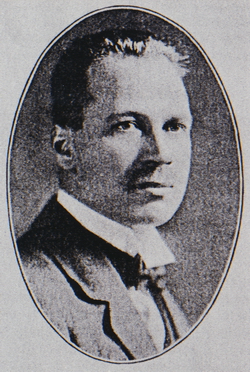
|
|
Arthur H. Morse
|
|
|
Five months after the armistice was signed, on April 15, 1919, Canada lifted the 1914 ban on wireless (35). There quickly followed the re-opening of the Marconi Wireless School in the basement of the factory at
173 William Street, Montreal (36) and the Department of the Naval Service amended the Radiotelegraph Act (37). By law, amateurs were now restricted to a wave length of 200 metres while the commercial wave length
for ships and shore stations was 600 metres, all signalling still on spark (38). Finally, Naval Service renewed its pre-war X-calls, consisting of "X" plus two other letters (39), including renewing Marconi's XWA call letters.
An important move toward working on wireless telephony (W/Tp) in Montreal was when MWTCC President J.N. Greenshields approved appointing Arthur Hyatt Morse, "a highly technical man" from the English company,
as the new Managing Director (40).
The New Mark II W/tp Sets at the MWTCC
Even before official approval, the MWTCC ordered two of Maj. Prince's 0.5 kW Mark II choke-controlled transmitters and receivers from the Imperial War Department, then 36 more for aeroplanes and for the Toronto
Aviation School (41). After war's end, some of these little aeroplane W/Tp sets arrived in the workshop on the second floor of the Montreal Marconi factory, the room locked as "Strictly Private" (42). Presumably,
it was one of these top-secret inter-aeroplane Mark II W/Tp sets that was eventually exhibited to the press in Montreal in early 1919. We are extremely fortunate to have been able to find two independent newspaper
reports of that first Canadian voice broadcasting experiment, reports that no other researcher had been able to find over the intervening century.
The Very First W/Tp Broadcast in Canada
After secret, in-house testing and the erection of an aerial on the factory roof (43), the very first public demonstration of a W/Tp broadcast in Canada was given by a MWTCC engineer from that second-floor test
room in the William Street factory. Certainly, it was pre-announced to the press, since reporters attended and two independently written reports were published of that initial W/Tp demonstration. In The Montreal Standard:
"Two small electric bulbs with four receiving wires on the top and two transmitting at the bottom. Inside a delicate mechanism which acts the part of an ordinary telephone..... Downstairs in the basement with the
two cup receivers on the ears, the words read from a book beside the two suspended bulbs came down through the several floors with its whirring machinery, clear and bell like. The words are read from their
vibrations through the noisy cubic space of the building" (44).
The power output was 0.5 kW, but the wavelength used is unknown. A quite different version appeared in The Montreal Daily Star of March 21, 1919:
"This morning a representative of The Star listened in to ‘Annie Laurie' being whistled over a wireless telephone. The engineer on the upper floor of the Marconi building was giving a demonstration of the wireless
telephone while The Star man was in the basement.
COULDN'T TALK SO WHISTLED
"It is difficult to make conversation over any phone when one has nothing in particular to say, so the engineer admitted, and he read a passage out of a magazine, and then he was called on to sing a song.
He admitted that he was no singer, but could whistle. An Irish tune was requested, and finally a compromise was made with ‘Annie Laurie'.
"The voice is heard much plainer over the wireless telephone than over the ordinary apparatus at present in use. There is no buzzing and no harsh sounds, and every word comes distinct and clear. It is the
same as sitting opposite a person at a table and conversing with him in the ordinary tone of voice" (45).
A reminder that this in-house W/Tp demonstration took place in March, just five months after the signing of the armistice. It was almost a month later, on April 15, 1919, that the government Order-in-Council
ban on wireless, under the War Measures Act of 1914 (P.C. 2030), was lifted (46). So, somehow the MWTCC got away with transmitting while the country was still under the wireless ban.
On the very day of XWA's experimental broadcast, MWTCC's Chief Engineer, J.O.G. Cann, was bold enough to announce that tunable W/Tp sets would soon be installed in the office of MWTCC President J.N. Greenshields,
in the Board of Trade and at the Marconi shore wireless stations in Three Rivers, Kingston and elsewhere. He added that a W/Tp was already operating in the Marconi factory in Montreal (47), but commercial
installation would cost $1500 to $2000 (48). At this point, Marconi engineers were planning to market the new W/Tp to remote mining and forestry companies as secure field-to-headquarters messaging, much
more cheaply than with the common land-line telephone, which required the laying and maintenance of expensive land-lines. They soon realized that this W/Tp scheme was impractical since even that low-power
transmission from the second floor of the factory had radiated for several miles all around Montreal and vicinity, so could be heard by enterprising amateurs in the city and by ships across and along the river.
Who was the MWTCC's first W/Tp broadcaster?
As well as not knowing the date, previous researchers have never been able to identify that un-named Marconi engineer, the pioneering announcer-operator (A/O)-whistler on that first W/Tp broadcast over XWA.
Nor could they define anything of the content of the broadcast. One possible candidate as the first W/Tp A/O could have been Chief Engineer John Osmond Gilbert Cann, but he was more of a company spokesperson
than a W/Tp technician. More likely, the first A/O was electrical engineer Arthur Salkeld Runciman, who was later the engineer-in-charge in MWTCC long-distance W/Tp tests in February, 1920 (49) and who,
around April 1920, built one or more W/Tp sets with which he communicated from Montreal to the Three Rivers shore station (50).
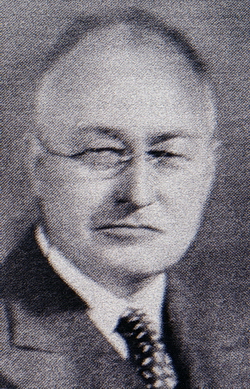
|
|
Arthur Salkeld Runciman
|
|

|
|
A.S. Runciman and his daughter Marguerite
|
|
|
There is a telling piece of family information that came to light, a story that points to Arthur S. Runciman as the first A/O-whistler who broadcast over XWA on March 21, 1919. His daughter, Mrs. Marguerite MacLean,
testified:
"Yes. Dad loved to sing. In a deep bass. He wasn't very good at singing and not encouraged by the family. He was an excellent whistler though, and could whistle tunes, birds or even daily sounds, much to our
entertainment.... . he was busy doing his experiments with radio while I was a baby (born 1919). I do have early memories of Dad with headphones clamped to his ears doing something strange a great deal of the
time while we lived in Highlands, a suburb of Montreal....We liked your discovery of the whistling" (51).
Testing of Arthur Runciman's W/Tp sets in February and April, 1920; Newspaper Reports and Personal Recollections:
As mentioned, in February, 1920, Runciman was engineer-in-charge in the first and longest distance tests yet of two-way W/Tp conversations between Montreal and the Citadel in Quebec City, and then with the
Rimouski shore station (52). The newspaper mentioned "The pure tone and clarity of the voice being audible in any part of the room.....two gramophone selections were unimpaired". At the Citadel in Quebec City
were Arthur H. Morse, Managing Director, A.S, Runciman, engineer-in-charge, J.E. Boutellier, operator-in-charge and G.E. Clegg, operator, with observers Frank Carrel and E.G. Smith. Morse observed at the time
that steamship companies could now have an orchestra play anywhere in the world and supply their whole fleet with W/Tp concerts (53).
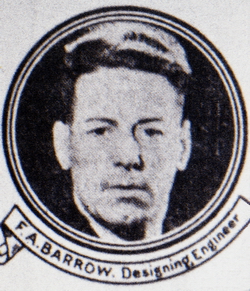
|
|
Fred Barrow
|
|
|
A month later, engineer Runciman built W/Tp sets that were successful in local and long-distance tests, suggesting that Runciman had some special expertise with W/Tp at Montreal Marconi. What he did then was to
set up a breadboard circuit on a small cart, with a 500-volt battery and a Captain Round-type transmitting tube (Maj. Prince's modified Audion), all connected to an antenna on the factory roof (54).
Frederick A. Barrow left reminiscences of these long-distance W/Tp test broadcasts by his colleague, Arthur Runciman:
Fred A. Barrow: "On the writer's return from Sable Island, March 28, 1920, he was assigned to experimental work on a Wireless Telephone Set constructed by Arthur Runciman. Since little had been done in
regard to trials on the unit, Mr. Runciman and the writer decided to make a survey before carrying out further development. To start, we were requested to give a demonstration to the press which was to be held
within the confines of our William Street building, with the transmitter located on the top floor and receiving equipment in the basement. The intent was to show our guests the general theme of things associated
with the transmitter and receiver. The valve used in the transmitter was a type designed by Capt, Round and used in British Army Mobile Equipment toward the end of World War One.
"The receiver contained a tuned circuit connected to a multi-tube amplifier known as a Type 55A.
"The demonstration having been carried out under one roof did not prove very convincing with the result that little, if any, enthusiasm was displayed" (55).
Barrow wrote that "No reference to this episode could be found in press releases" (56).

|
|
Marconi engineers in bivouac, testing wireless equipment out in a field at Three Rivers, 1920.
|
|
|
Fred Barrow: "Two days later (c. April 8 -12, 1920, after the unreported press demo) and two weeks prior to the opening of navigation, Mr. Runciman and the writer carried out tests with the same equipment,
but this time between our laboratory in the William Street building and (myself at) our Marine Station on Tarte Pier, a distance of five miles. The results of this test were satisfactory but an hour later there was
cause for real enthusiasm when Operator Harris of VDL on board the ice-breaker ‘Lady Grey' in Lake St. Peter, 30 miles east of Montreal, sent a service stating, ‘Signals strong, Speech clear'. No log was kept and
operator Harris was deceased before corroboration could be made.
"Three days later and a few modifications to the same equipment, an effort was made to contact Three Rivers Marine Station (VCB), also Quebec (VCC) and Father Point (VCF). The result with Three Rivers,100 miles east
of Montreal, was fairly good but the other two stations were out of range" (55; 56).
About the Steamship the Lady Grey
That the ice-breaker Lady Grey (a twin-screw steamer; 172 feet, 1055 tons), equipped with wireless since 1911, was working and could have received Runciman's and Barrow's W/Tp transmission on Lake St. Peter,
about 30 miles away, circa April 10-12, is supported by the annual report of the Department of Marine and Fisheries for 1920:
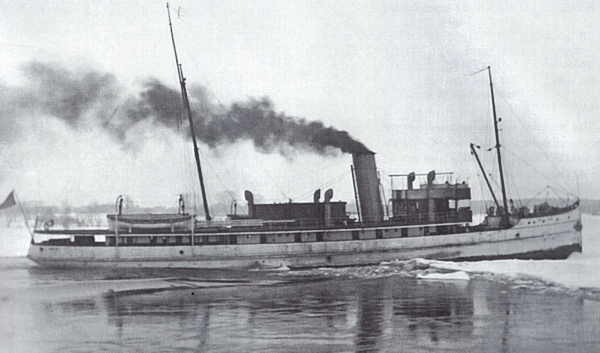
|
|
The Lady Grey
|
|
|
"On April 10 and 11 the Lady Grey worked at the foot of Lake St. Peter, keeping the ice moving there. On the 12th, the lake was clear and she proceeded up to the Sorel Islands, where a jam was broken up.
On the 13th she arrived at Sorel, and from that date to the 17th, was engaged between Pte. aux Trembles and Lake St. Peter, breaking up jams and keeping the ice running" (57).
Therefore, even though no log of the service report from Operator Harris was kept and no personal corroboration was made, it is clear that the Lady Grey was in or near Lake St. Peter at the time of
its W/Tp reception from Montreal.

|
|
Marconi YC3 Fonet wireless telephone and telegraph set, 0.5 kW, minimum range for W/Tp of 100 miles, the case measuring 4 by 4 feet and 2 feet wide. It held three large vacuum tubes, a Marconi 3-electrode M.T.I. oscillation transmitting valve on the left, a 2-electrode M.R.I. rectifying valve in the centre and a second M.T.I. control valve on the right for controlling amplitude in W/Tp. For receiving, a 7-valve amplifying detector, with upright glass tubes, is on the far right of the box.
|
|
|
Barrow's Secret W/Tp Demonstration in Toronto
Also in April, 1920, Fred Barrow was assigned by the MWTCC to demonstrate the Marconi 0.5 kW YC3 Fonet equipment, newly arrived from England and installed in the Marconi offices at 73 King Street East, Toronto.
It was a strictly private W/Tp demonstration of this upright-piano-sized console, the broadcast to be received at the home of Sen. Frederic Nicholls at 79 St. George Street, in the presence of members of parliament
and government ministers, including Sir Charles White, Minister of Finance. There was no publicity of any kind allowed, no amateur reports surfaced and nothing reached the newspapers - it was "airtight in sofar as
publicity was concerned" (56, 55). Fred Barrow did not speculate on the purpose of this top-secret W/Tp broadcast to Dominion Members of Parliament.
In Conclusion
It is clear and quite well-documented that the very first W/Tp transmission in Canada, made from Canadian MWTCC's Experimental Radio Room on William Street in Montreal, using the old
call letters XWA, happened on March 21, 1919, and the A/O broadcaster had to have been Marconi engineer Arthur Salkeld Runciman. It is quite possible that fellow engineer Fred A. Barrow was also in the
Radio Room, assisting.
Arthur Salkeld Runciman (1880-1973)
Arthur Salkeld Runciman was born in Goderich, Huron County, Ontario, and studied engineering at the University of Toronto (class of ‘11). After graduation, Arthur gained experience with electrical power companies
in Western Canada and with the Marconi Wireless Telegraph Company of Canada on trans-Atlantic wireless research. In 1921, he became Chief Engineer and Superintendent of transmission lines at Shawinigan Water and
Power Company, in Quebec. There his initiative and genius paved the way for multiple communications on telephone lines strung along high-tension live circuits. Such developments helped make possible the Trans- Canada
Telephone Systems, which was inaugurated in 1932 (58). For his thesis on this work, Runciman was awarded the Post-graduate Degree in Electrical Engineering in 1928.
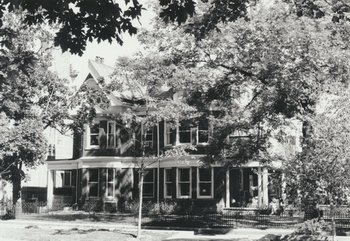
|
|
In 1920, 79 St. George Street received a private broadcast from the Marconi offices at 73 King Street East in Toronto.
The Marconi offices on King Street are long gone, but the big house at 79 St. George is now part of the University of Toronto campus.
|
|
|
Arthur Runciman was awarded the very first University of Toronto Engineering Alumni Medal, in 1939 (59) and, in 1945 was president of the Montreal branch of the University of Toronto Alumni.
Frederick A. Barrow (vital dates unknown)
Barrow probably graduated from McGill around the time of the First World War and began working for the engineering department of Montreal Marconi in January, 1915,
his duties on the installation of ship spark W/Tg. He became an Associate of the Radio Engineers in 1923 and was last listed with them in 1953 (60). Barrow was made Engineer-in-Charge of the Marconi trans-Atlantic
station at Louisburg, the Designing Engineer in charge of broadcaster receiver development, then Manager of the Technical Resources Division in 1943, guiding their Crystal Laboratory (61).
Afterwords
And just two days before the initial MWTCC broadcast in Montreal, the English Marconi company announced a technical feat with its W/Tp, that one of their engineers in Ballybunion County, Ireland,
had sent a voice message from a single-valve little transmitter at 3800 metres, and that transmission was received on a Marconi V55 receiver at Louisburg, Cape Breton, Nova Scotia,1,800 miles away (62). Actually,
Bell Telephone Systems in the U.S. had beaten the British by years, by sending a transatlantic W/Tp message from the Arlington Naval Station in Virginia to the Eiffel Tower, Paris, in October, 1915.
It quickly became clear to entrepreneurs that the W/Tp could not be marketed as a secure point-to-point means of communication, as private as but cheaper than the land-line telephone. It took a couple of years
for engineers and administrators everywhere to switch their gears and to re-think the W/Tp, not as a telephone but as a widely-distributed (that is, broad-cast) service to the public, as the "Pleasure Telephone"
people had done before 1900, as Charles Herrold of San Jose, as Frank Conrad of Pittsburgh and as Hans Idzerda of the Hague had done with wireless telephoning years before and just after WW I. The new wireless
telephone concept would be able to air news, stock reports, weather, sports and music, and would soon be put onto a commercial basis, selling air time to advertisers, and eventually connecting the world.
REFERENCES
- Publicity Dept., Canadian Marconi, undated, by H.S. Putnam.
- Arthur H. Morse in "Telegraph and Telephone Age", Dec. 1, 1924, p. 553.
- "The Telephone", NYT, March 22, 1876, p. 8; "The Telephone at the Paris Opera", Sci. Amk., Dec. 31, 1881, p. 422; "Song, Mirth and Music by Wire to Your Home" in This England, Winter, 1889; "The Pleasure Telephone" by Arthur Mee, Strand Magazine, Sept. 1898; "The Culture of Time and Space, 1880-1918" by Stephen Kern, Harvard U.P. Cambridge, Mass. 1983; "Birth of Broadcasting; Who is the Father of Broadcasting?" by Pat Hawker; Electronics World, May 1997, p. 418.
- Montreal Daily Star, Dec. 1, 1878, p. 2.
- Montreal Daily Star, May 11, 1920, p. 10.
- Times, London, April 29, 1899, p. 13.
- New York Herald, Oct. 4, 1899, p.7.
- Daily News, London, Dec. 16, 1901, p. 4; Evening Telegram, St. John's, Dec. 16, 1901, p. 4.
- James L.W. Gill, Queen's Quarterly, Jan. 15, 1908, p. 230.
- "Styles and Credit in Early Radio Engineering: Fleming and Marconi on the First Transatlantic Wireless telegraphy" by Sungook Hong in Annals of Science 53, p. 431-65, 1996.
- "In the Shadow of the Shield" by Dr. Arthur E. Zimmerman, self-published, 657 pages, 1991; pp. 12 and 17.
- Manuscript by H.L. Chadbourne, La Jolla, Calif., 1982.
- San Francisco Call, Oct. 15, 1905.
- Electrical World, vol. 53 #1, p. 13, 1909.
- Telephony, March 5, 1910, p. 293; New York Times, June 24, 1982, sec. 2, p. 23; Hearings Before a Subcommittee of the Committee on Naval Affairs of the House of Representatives, 1910, HJ Resolution 75.
- "Broadcasting's Forgotten Father: The Charles Herrold Story" by Mike Adams, in Antique Radio Classified 11 #10, p. 4, Oct. 1994; "A Tower in Babel: A History of Broadcasting in the United States - to 1933" by Erik Barnouw; Oxford U.P., New York, 1966.
- "Broadcasting's Forgotten Father: The Charles Herrold Story", a VHS tape issued by the Electronics Museum of the Perham Foundation, Los Altos, Calif.
- "Concerts by Wireless", Times, London, March 30, 1914, p. 8.
- "The Foundations of Modern Radio" by L.W. Chubb and C.T. Alcuitt, in The Electric Journal, p. 121, April. 1921; "Radio's First Voice" by Ormond Raby, Macmillan, Toronto, 1970.
- Scientific American. Vol. 96 #3, Jan. 19, 1907, p. 68.
- Transactions of the American Institute of Electrical Engineering, Vol. 27, pt 1, 553, June 29, 1908; The American Telephone Journal, Vol. 16 #3, 165, September 1908.
- "Fessenden: Builder of Tomorrows" by Helen M. Fessenden; Coward-McCann, New York,1940.
- Electrical World, vol. 48 #18, p. 836, 1906.
- New York Times, Oct. 23, 1914, p. 3.
- "A History of the Marconi Company, 1874-1965" by W.J. Baker; Routledge, Oxfordshire, 1970.
- "Telegraph and Telephone News", Electrical Review, Dec. 27, 1918, p. 632.
- Times, London, March 14, 1919, p. 11; "A History of the Marconi Company", by W.J. Baker, Methuen, 1970, p. 170.
- "The Hague Concerts", The Wireless World, April 30, 1921, p. 65; "Birth of Broadcasting, ibid.; "Radio, Radio" by Jonathan Hill; Sunrise Press, Devon, 1986.
- "Inventing American Broadcasting, 1899-1922" by Susan J. Douglas; Johns Hopkins University Press, Baltimore, 1987, p. 299.
- Montreal Daily Star, Sept. 5, 1930, p. 26.
- Canada Gazette, June 20, 1914, p. 4456.
- Report, Department of the Naval Service, fiscal year ending March 31, 1915, Sessional Paper No. 38, 6 Geo V, 1916, Vol 51 #27, 1916.
- Sessional Papers of the House of Commons, No. 38, March 31, 1915, page 119.
- Montreal Gazette, March 22, 1919, p. 5.
- Canada Gazette, vol. 52, p. 3436, May 10,1919.
- Montreal Standard, April 19, 1919, p. 34.
- Canada Gazette, p. 3377, May 3, 1919.
- Montreal Daily Star, May 8, 1919, p.3.
- QST, Sept. 1919, p. 27.
- MWTCC special board meeting, May 27, 1919, p. 141.
- Minutes, Exec Ctte of Board, MWTCC, April 25, 1917, pp. 7-8; May 3, 1917, pp. 10-11; May 31, 1917, Public Archives of Canada MG 28 III, 72 Book IV.
- Montreal. Standard. March 22, 1919, p. 13.
- Minutes, Exec Cttee, Bd of Dir, MWTCC, March 20, 1919, p. 67.
- Montreal. Standard., March 22, 1919, p. 13.
- Montreal Daily Star, March 21, 1919, p. 3.
- The Canada Gazette, Vol. LII #40, 3436, May 10, 1919.
- Montreal Daily Star, March 21, 1919, p. 3.
- Montreal Daily Star, March 25, 1919, p. 3.
- Montreal Daily Star, February 26, 1920, p. 3.
- Comments on the early days of W/Tp by Fred A. Barrow, Sept. 28, 1966, unpublished.
- Personal communications from Marguerite MacLean, October 18 &14, 2003.
- Montreal Daily Star, February 26, 1920, p. 3.
- Montreal Gazette, February 26, 1920, p. 4; Quebec Telegraph, February 25, 1920, p. 4.
- "Canada's Fifty Years of Broadcasting" by D.R.P "Darby" Coats, chapter 2; notes from Roger Hart, Morrisburg, Ont., April 23, 1997.
- Comments on the early days of wireless telephony by Fred A. Barrow, Canadian Marconi Company (CMC), Montreal, September 28, 1966 - unpublished, courtesy Roger Hart, Morrisburg, Ont., April 23, 1997.
- Notes from Barrow's interviews with Runciman, Scantlebury and Hawes of CMC, re April 6 -12, 1920; CMC Inter-departmental from F.A. Barrow to W.V. George, August 29, 1962.
- Sessional Papers of the House of Commons, LVII #7, 1921, Marine and Fisheries Sessional Paper No. 21, Ottawa, Nov. 1920. 11 Geo V, A. 1921 - report of N.B. McLean, Resident Engineer.
- Fac. Appl. Sci. & Eng., Alumni & Friends, U. Of Toronto, November,1939, p. 39.
- Toronto Telegram, November 8, 1939, p. 11.
- Personal communication from Archivist, McGill University Alumni Association, May 16, 2002; personal communication from James Coats, July 11, 2005.
- Marconi News, vol. 5 #5, May 1945.
- Montreal Daily Star, March 19, 1919, p.1; Halifax Herald, March 21, 1919, p. 1; note from Roy Rodwell, English Marconi, October 18, 1996.
Thanks to:
James Coats, Guelph
John Ross Cann, Waterloo
Marguerite MacLean, Kingston
Hydro Quebec
Marconi Company, Great Britain
Public Archives of Canada, Ottawa
Archivist, McGill University Alumni Association
Roger Hart at Old Authors Farm, Morrisburg
Engineering Institute of Canada
Bill Pratt of CAPS for technical advice
Mark Caruana-Dingli of CAPS
Domenic DiBernardo of CAPS for Victor II photo
Reference 11: "In the Shadow of the Shield: The Development of Wireless Telegraphy and
Radio Broadcasting in Kingston and at Queen's University, 1902-1967", a 657-page hardcover book is available from the author, Dr. Arthur E. Zimmerman, at << arthurz@look.ca >>.
A referee for the Ontario Heritage Foundation grant said: "This is clearly a work for the historian or reader in the history of science, technology and engineering. The work is
well documented, draws carefully from a variety of sources and, most important of all...preserves valuable oral evidence....fills an important need....see it as standing the test
of time....provides local history that is truly different and, more important, a source of great insight".
|